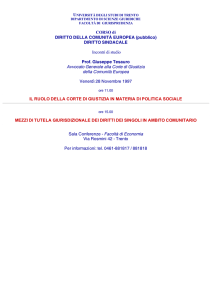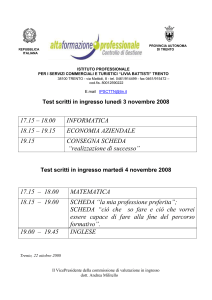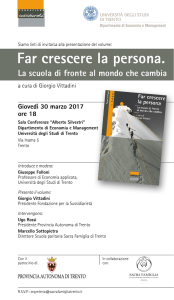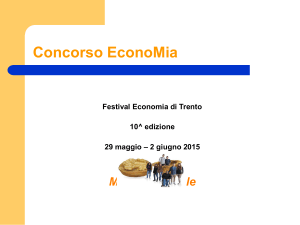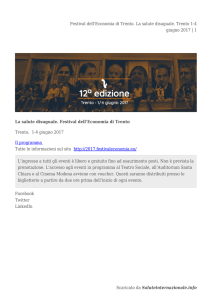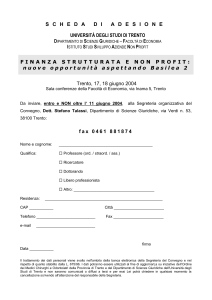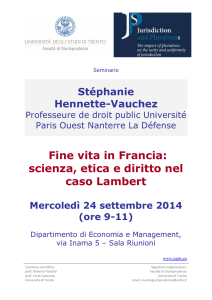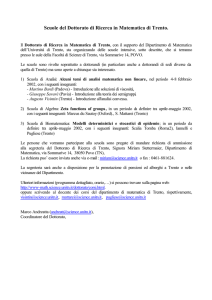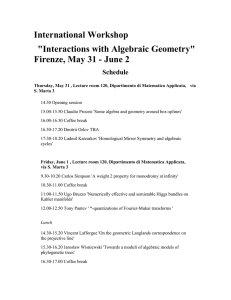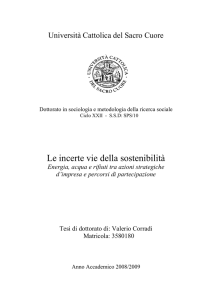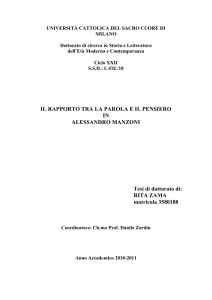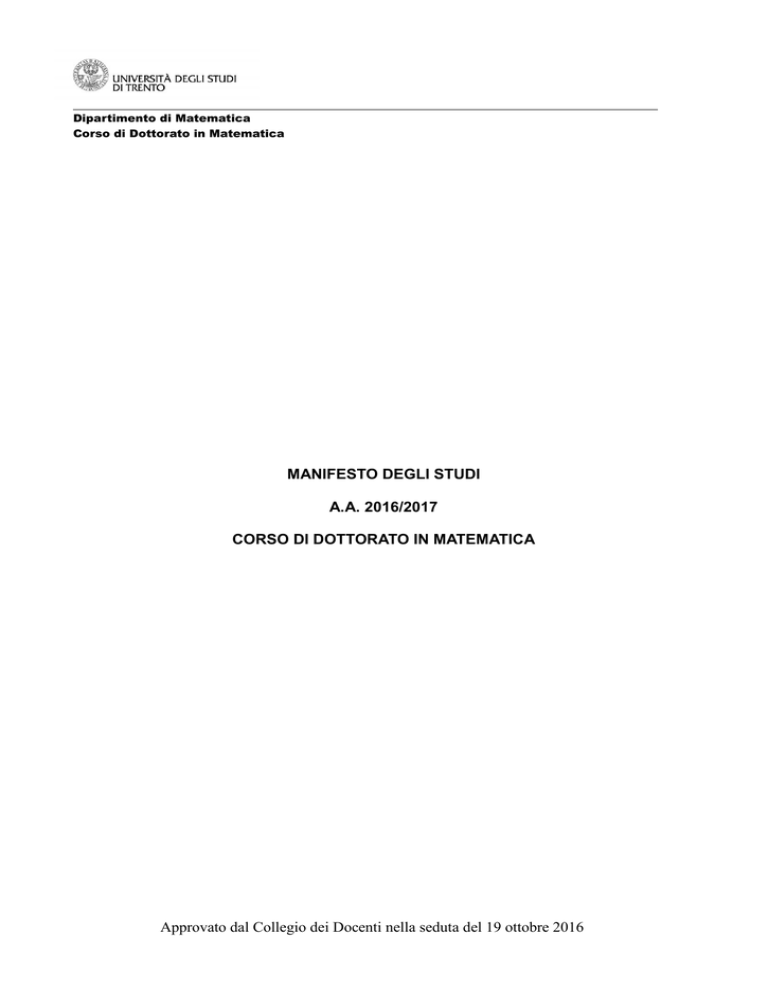
Dipartimento di Matematica
Corso di Dottorato in Matematica
MANIFESTO DEGLI STUDI
A.A. 2016/2017
CORSO DI DOTTORATO IN MATEMATICA
Approvato dal Collegio dei Docenti nella seduta del 19 ottobre 2016
Dipartimento di Matematica
Corso di Dottorato in Matematica
Manifesto degli studi
Il Corso di Dottorato in Matematica ha come finalità l’acquisizione di una qualificata preparazione
per una formazione specialistica di giovani ricercatori, avviandoli a svolgere una futura attività
presso Università, Enti di ricerca pubblici e privati, ed industrie. Il Corso si configura come naturale
completamento della formazione scientifica conseguita con le lauree di primo e secondo livello,
con le quali è coordinata.
Il Corso di Dottorato di ricerca in Matematica è istituito ai sensi del D.M. n. 45/2013.
Il Corso di Dottorato viene proposto dal Dipartimento di Matematica. Alcune borse di studio sono
offerte da enti esterni, sulla base di convenzioni approvate.
Al corso di Dottorato collaborano, mettendo a disposizione degli allievi le proprie competenze e le
proprie strutture, i seguenti enti di ricerca nazionali e locali:
Università di Verona
FBK - Fondazione Bruno Kessler, Trento
COSBI
FEM
INdAM
Indirizzi di ricerca
Il Corso di Dottorato di ricerca in Matematica, per l’anno accademico 2016/2017 è articolato
nei seguenti indirizzi di ricerca:
a. Indirizzo generale
L’indirizzo riguarda una o più delle seguenti aree scientifiche caratterizzanti:
Calcolo delle variazioni: analisi in spazi metrici, teoria geometrica della misura,
convergenze variazionali (Gamma-convergenza), trasporto ottimo
Analisi Geometrica, Geometria Riemanniana, Flussi Geometrici.
Equazioni alle derivate parziali (EDP) non lineari: problemi a frontiera libera, modelli di
isteresi, comportamento asintotico ed omogeneizzazione di EDP, metodi variazionali e
topologici, equazioni di Ginzburg-Landau e Schrödinger non lineari
Geometria analitica e geometria algebrica:
Curve algebriche e spazi di moduli.
Superfici di tipo generale e spazi dei moduli
Varietà di dimensione alta: teoria di Mori, varietà di Fano.
Geometria algebrica reale, analisi complessa e ipercomplessa.
Fisica matematica: aspetti fondazionali, analitici e geometrici delle teorie quantistiche e
relativistiche. Tecniche geometriche in meccanica analitica; applicazioni alla teoria del
controllo.
Sistemi Dinamici e Teoria del Controllo: esistenza, molteplicità, stabilità di soluzioni
periodiche di equazioni differenziali, sistemi lagrangiani e hamiltoniani; giochi differenziali e
Approvato dal Collegio dei Docenti nella seduta del 19 ottobre 2016
Dipartimento di Matematica
Corso di Dottorato in Matematica
-
-
problemi di controllo ottimo, soluzioni di viscosità di equazioni di Hamilton-Jacobi;
ottimizzazione di sistemi ibridi.
Processi stocastici: equazioni differenziali stocastiche alle derivate parziali, Integrazione
funzionale ed applicazioni.
Statistica: Statistica Robusta, Misure statistiche di profondità dei dati Statistica
Computazionale.
Logica matematica ed informatica teorica: applicazione di tecniche non standard (alla A.
Robinson) in analisi funzionale, sviluppo di logiche non classiche, teoria dei linguaggi di
programmazione, sistemi di tipi, analisi statica, aspetti generali e filosofici, fondamenti,
matematica costruttiva e programma di Hilbert.
Teoria di Lie, teoria dei gruppi, rappresentazioni di algebre, algebra omologica, algebra
computazionale.
b. Indirizzo "Modellizzazione Matematica e Calcolo Scientifico (MOMACS)"
L’indirizzo è trasversale alle seguenti aree scientifiche caratterizzanti:
Processi Stocastici: equazioni integro-differenziali e EDP stocastiche per modellizzazione di
fenomeni fisici, biologici e finanziari.
Metodi Numerici per Equazioni a Derivate Parziali: modellizzazione di fenomeni
elettromagnetici, e di problemi di fluidodinamica (classica e quantistica), metodi di
approssimazione basati su elementi finiti, elementi di frontiera, differenze o volumi finiti.
Approssimazione/interpolazione numerica di funzioni multivariate: metodi efficienti ed
applicazioni.
Matematica discreta: modellizzazione in ricerca operativa, teoria dei grafi, ottimizzazione
combinatorica e applicazioni in biologia computazionale.
Controllo ottimo, ottimizzazione: applicazioni alla scienza delle decisioni, trattamento delle
immagini, patrimonio culturale.
c. Indirizzo "Metodi algebrici e geometrici in crittografia e teoria dei codici"
L’indirizzo si propone di avviare la ricerca nel campo di una varietà di metodi matematici impiegati
in crittografia, e nella teoria dei codici a correzione d'errore, in particolare:
Metodi algebrici: algebra lineare, algebra commutativa, algebra computazionale, basi di Groebner,
campi numerici, teoria dei gruppi;
Metodi geometrici: geometria algebrica, curve ellittiche.
I problemi di ricerca proposti spaziano da classificazioni puramente teoriche a problemi vicini alla
ricerca industriale, questi ultimi complementati da stage presso aziende leader del settore.
d. Indirizzo “Biologia matematica e computazionale”
L’indirizzo si propone di avviare alla ricerca nel vasto campo dell’applicazione di modelli matematici
e computazionali nella biologia.
Approvato dal Collegio dei Docenti nella seduta del 19 ottobre 2016
Dipartimento di Matematica
Corso di Dottorato in Matematica
I metodi che verranno approfonditi possono andare dalla teoria delle equazioni differenziali
ordinarie, parziali e con ritardo o dei processi stocastici, alla statistica computazionale, alla
bioinformatica, ai metodi formali per la descrizione di sistemi complessi.
Anche le aree della biologia coinvolte sono molteplici, dall’epidemiologia ed ecologia, alle reti
molecolari con applicazioni alla farmacologia sistemica e alla nutrigenomica.
Il lavoro di tesi consisterà nella modellizzazione di un problema biologico, con l’ausilio di metodi
matematici, statistici, computazionali, informatici. Esso potrà coinvolgere altri centri di ricerca in
provincia di Trento (COSBI, FBK, FEM) o altrove.
Corsi attivati per l’anno accademico 2016/2017:
I corsi attivati sono contenuti nell’allegato documento “Manifesto dei corsi”. In accordo con l’art. 6
del regolamento interno del dottorato, uno studente del I anno di corso dovrà scegliere tre corsi del
manifesto:
-
Algebra e logica matematica
Analisi Matematica
Analisi Numerica
Geometria
Fisica Matematica
Probabilità e Statistica/Metodi matematici dell’economia
Ricerca Operativa/Informatica
Approvato dal Collegio dei Docenti nella seduta del 19 ottobre 2016
Dipartimento di Matematica
Corso di Dottorato in Matematica
Allegato n. 1
Courses of the PhD School in Mathematics, a.y. 2016-17
INdAM Interdisciplinary Course (Algebra, Geometry, Mathematical Physics)
1. Title: Quantum information theory and geometry
-
-
-
-
-
Lecturer: Joseph M. Landsberg (Texas A&M, USA) INdAM Visiting Professor
Period: June-July. Approximately 30 academic hours.
Venue: Trento
Program: Quantum information theory is at the intersection of physics, computer science and
mathematics. While it is little understood, what we know already may have a dramatic impact on our
lives. Efforts are now being made to build a quantum computer, which, if successful, would in particular
end the security of public key cryptography among many other things. At the present, we have very
little knowledge of what a quantum computer can and cannot compute efficiently. Much research
remains to be done.
This course will discuss the physics of information, and the mathematics needed to study it. The first
half will cover background material from physics and computer science. It will give an overview and
foundation of the subject. The second half will be an in-depth study of geometry and representation
theory useful for quantum information theory. The mathematics covered will prepare students to do
research in this exciting and important area.
The primary target of the lectures are first year PhD students. However given its timely and
interdisciplinary nature, it should also attract students and faculty in mathematics, physics and
computer science.
Topics (approximately 5 hours of lecture each): 1. Classical information theory (Shannon capacity,
complexity). 2. Quantum information theory and its connections to probability. 3. Quantum complexity
and algorithms. 4. Representation theory for quantum information. 5. Algebraic geometry for quantum
information.
References: [1] J. Preskill, Lecture notes on Quantum Information Theory
http://www.theory.caltech.edu/~preskill/ph229/#lecture. [2] Kitaev, A. Yu.; Shen, A. H.; Vyalyi, M. N.
Classical and quantum computation. Translated from the 1999 Russian original by Lester J. Senechal.
Graduate Studies in Mathematics, 47. American Mathematical Society, Providence, RI, 2002. xiv+257
pp. ISBN: 0-8218-2161-X. [3] Landsberg, J. M.; Tensors: geometry and applications. Graduate Studies in
Mathematics, 128. American Mathematical Society, Providence, RI, 2012. xx+439 pp. ISBN: 978-0-82186907-9.
Approvato dal Collegio dei Docenti nella seduta del 19 ottobre 2016
Dipartimento di Matematica
Corso di Dottorato in Matematica
Curriculum 1: Pure Mathematics
1. Mathematical Logic
1.1 Title: Set Theory (borrowed from the master degree in mathematics at Trento)
Lecturer: Stefano Baratella (University of Trento)
Period: February 20 – April 30. Approximately 30 academic hours.
Venue: Trento
Program: Axioms for the Zermelo-Fraenkel set theory. Well-orderings and ordinals. Elements of ordinal
arithmetic. Equivalents of the axiom of choice. The axioms of choice in the mathematical practice.
Cardinal numbers. Cardinal arithmetic. Cardinal arithmetic under the generalized continuum
hypothesis. An application: the problem of extension of Lebesgue measure and the existence of weakly
inaccessible cardinals.
References: [1] Kunen K., Set theory -- An introduction to independence proofs, North-Holland. [2] Jech
T Set theory -- The 3rd millenium edition, Springer, [3] Devlin K., The joy of sets, Springer.
2. Algebra
2.1 Title: Advanced Commutative Algebra (borrowed from the master degree in mathematics at Trento)
Lecturer: Alessandra Bernardi (University of Trento)
Period: February 20 – May 7. Approximately 30 academic hours.
Venue: Trento.
Program: The commutative algebra is an extremely versatile discipline. In addition to being itself a field
of research in mathematics both classical and contemporary, it has important consequences both in
computational framework that on the foundations of modern algebraic geometry, not to mention the
recent uses in the application environment.
The purpose of this course is to provide a good understanding of the foundations of modern
commutative algebra with a particular focus on computational methods and its use in algebraic
geometry. The final part of the course will introduce students to the most recent applications.
References: D. Eisenbud, Commutative Algebra with a View Toward Algebraic Geometry, Springer.
2.2 Title: Lie Algebras
Lecturer: Willem Adriaan De Graaf (University of Trento)
Period: February 20 – May 31.
Venue: Trento.
Program: The course gives an introduction to the theory of Lie algebras.
Subjects treated will include: nilpotency, solvability, Cartan's criterion, Cartan subalgebras, weight and
root decompositions, root systems and their classification, the classification of the semisimple Lie
Approvato dal Collegio dei Docenti nella seduta del 19 ottobre 2016
Dipartimento di Matematica
Corso di Dottorato in Matematica
algebras, irreducible modules over semisimple Lie algebras and their classification. If time permits we
will look at Chevalley groups constructed from semisimple Lie algebras.
References: J. E. Humphreys, Introduction to Lie Algebras and Representation Theory, Springer-Verlag
1978
3. Geometry
3.1 Title: Hodge Theory (borrowed from the master degree in mathematics at Trento)
-
Lecturer: Claudio Fontanari (University of Trento)
Period: February 20 – May 31.
Venue: Trento
Program: The goal is to provide a self-contained introduction to one of the Millennium Problems, the
Hodge Conjecture. 1. Holomorphic Functions in Many Variables. 2. Complex Manifolds. 3. Kaehler
Metrics. 4. Sheaves and Cohomology. 5. Harmonic Forms and Cohomology. 6. The case of Kaehler
Manifolds. 7. Hodge Structures and Polarisations. 11. Hodge Classes.
References: Chapters 1.,2.,3.,4.,5.,6.,7.,11. of Claire Voisin, "Hodge Theory and Complex Algebraic
Geometry I", Cambridge University Press 2002, pp. 1-183; 263-289.
3.2 Title: Algebraic Geometry 2: Toric Geometry (borrowed from the master
Trento)
degree in mathematics at
-
Lecturer: Luis E. Sola Conde (University of Trento)
Period: February 20 – May 31.
Venue: Trento
Program: Toric geometry studies a special type of algebraic varieties that can be described in terms of
discrete –combinatorial– data.
-
Though small and manageable, the category of toric varieties is rich enough to be used to illustrate
many of the basic concepts of algebraic geometry: affine and projective varieties, group actions,
smoothness and singularity, divisors, line and vector bundles, etc. The course is meant as an
introduction to algebraic geometry for PhD and Master students, for which we assume familiarity with
undergraduate geometry, basic algebraic structures and complex numbers.
-
(1) Affine Varieties. Affine toric varieties. Cones and lattices. (2) Abstracts algebraic varieties. Toric
varieties. Fans. (3) The orbit-cone correspondence. Properties of toric varieties. Smoothness. (4)
Projective toric varieties. (5) Divisors and line bundles on toric varieties. (6) Toric Surfaces. (7) Toric
Resolutions and Toric Singularities.
References: D. Cox, J. Little and H. Schenk: Toric Varieties, Graduate Texts in Mathematics 124, AMS
2009, http://www.cs.amherst.edu/~dac/toric.htmlComplementary references: [1] M. Atiyah and I. G.
MacDonald: Introduction to commutative algebra, Addison-Wesley, Reading, MA, 1969. [2] G. Barthel,
L. Bonavero, M. Brion, D. Cox: Notes of the (first week of the) course “Geometry of Toric Varieties”,
-
Approvato dal Collegio dei Docenti nella seduta del 19 ottobre 2016
Dipartimento di Matematica
Corso di Dottorato in Matematica
available at http://www-fourier.ujf-grenoble.fr/~bonavero/articles/ecoledete/ecoledete.html. [3] D.
Cox, J. Little and D. O’Shea: Ideals, varieties and algorithms: an introduction to computational algebraic
geometry and commutative algebra, 3rd ed., Springer, New York, 2007. [4] D. Eisenbud: Commutative
algebra with a view toward algebraic geometry, Springer, New York, 2000. [5] D. Eisenbud and J. Harris:
The geometry of schemes, Springer, New York, 2000. [6] W. Fulton: Introduction to toric varieties,
Princeton University Press, Princeton, NJ, 1993. [7] J. Harris: Algebraic geometry: a first course,
Springer, New York, 1992. [8] R. Hartshorne: Algebraic geometry, Springer, New York, 1977. [9] J. Little:
Software
for
Toric
Varieties,
http://mathcs.holycross.edu/~little/MathInTheMountains/MMTTSoftware.pdf. [10] H. Matsumura:
Commutative ring theory, Cambridge University Press, Cambridge, 1986. [11] E. Miller and B. Sturmfels:
Combinatorial commutative algebra, Springer, New York, 2005. [12] T. Oda: Convex bodies and
algebraic geometry, Springer, New York, 1988. [13] M. Reid: Undergraduate algebraic geometry,
Cambridge University Press, Cambridge, 1989. [14] H. Schenck: Computational algebraic geometry,
Cambridge University Press, Cambridge, 2003. [15] I. Shafarevich: Basic algebraic geometry, v. 1 and 2 ,
Springer, New York, 1994 and 1996. [16] G. Ziegler: Lectures on polytopes, Springer, 1995.
3.3 Title: Introduction to Graph theory and applications
-
Lecturers: Prof. Mazzuoccolo (Verona), Prof. Steffen (Paderborn).
Period: April-May 2017
1st part, Prof. Mazzuoccolo (18 hours):
Definitions and basic properties.
Matching in bipartite graphs: Konig Theorem and Hall Theorem. Matching in general graphs: Tutte
Theorem. Petersen Theorem.
Connectivity: Menger's theorems.
Planar Graphs: Euler's Formula, Kuratowski's Theorem.
Colorings: Four Colours Theorem, Five Colours Theorem, Brooks Theorem, Vizing Theorem.
2nd part, Prof. Steffen (12 hours):
-
-
Flows on graphs and networks. Nowhere-zero flows on graphs.
Nowhere-zero flows on signed graphs. Vertex-colorings of signed graphs.
4. Mathematical Analysis
4.1 Title: Control Systems and Applications: from single particles to complex systems.
-
Subtitle: Control and Optimal Control Along the Banks of the River Adige (joint doctoral course
Trento-Verona )
Approvato dal Collegio dei Docenti nella seduta del 19 ottobre 2016
Dipartimento di Matematica
Corso di Dottorato in Matematica
-
-
-
-
Lecturers: Antonio Marigonda (University of Verona), Fabio Bagagiolo (University of Trento)
Period: February 20 – April 30 divided in two non necessarily connected sub-periods of approximately
15 academic hours each.
Venue: Verona and Trento.
Program: First southern-part in Verona (lecturer Antonio Marigonda). Differential Inclusions and
Control Systems: In the first part of the course we will provide an introduction to differential inclusions
and their applications to optimal control problems.
After the introduction of some tools from nonsmooth and variational analysis, we will analyze the
properties of control systems whose dynamics are given by means of a differential inclusion, with
particular emphasis on some properties like existence of trajectories, compactness and approximation
of the set of admissible trajectories, relaxations, viability, and discussing the problem of selections and
parameterization.
Second northern-part in Trento (lecturer Fabio Bagagiolo). Dynamics and control on networks:
consensus algorithms, control, optimal control and mean field games. We will first briefly review the
necessary graph theory and introduce the principal consensus algorithms (each node of the graph
(network) may represent an agent who exchanges information with other agents through the network,
the information being represented by a scalar parameter; information then evolves and eventually
possibly reach a common level (consensus)). Then we will briefly review the dynamic programming
principle and the Hamilton-Jacobi-Bellman theory for optimal control problems. We will also treat the
model of transport equation on a network. Finally, we will analyze some recent results for control,
optimal control and mean field games for dynamics constrained in a network.
References: Southern-part: [1] J.P. Aubin, A. Cellina, Differential Inclusions, Springer-Verlag, 1984. [2]
J.P. Aubin, H. Frankowska, Set-valued analysis, Birkauser, 2009. [3] F. Clarke, Y. Ledyaev, R. Stern, P.R.
Wolenski, Nonsmooth Analysis an Control Theory, Springer-Verlag, 1998 Northern-part. [1] W. Ren and
R.W. Beard: Distributed consensus in multi-vehicle cooperative control. Springer, 2008, [2] M. Bardi and
I. Capuzzo Dolcetta: Optimal Control and Viscosity Solutions of Hamilton-Jacobi-Bellman Equations,
Birkhauser 1997, [3] F. Ceragioli, C. De Persis, and P. Frasca: Discontinuities and hysteresis in quantized
average consensus. Automatica, 47(9):1916–1928, 2011. [4] G. Como, F. Fagnani, and S. Zampieri: I
sistemi multi agente e gli algoritmi di consenso. La matematica nella Società e nella Cultura: rivista
della Unione Matematica Italiana. Serie I, 5(1):1–29, 2012. [5] F. Camilli, E. Carlini, C. Marchi: A model
problem for Mean Field Games on networks, Discrete Contin. Dyn. Syst. 35 (2015), no. 9, 4173--4192.
[6] Y. Achdou, F. Camilli, A. Cutrì, N. Tchou: Hamilton-Jacobi equations constrained on networks, NoDEA
Nonlinear Differ. Equ. Appl., 20 (2013), 413-445. [6] F. Bagagiolo and D. Bauso: Mean-field games and
dynamic demand management in power grids, Dynamic Games and Applications, 4 (2014), 155 - 176.
[7] F. Parise, M. Colombino, S. Grammatico, J. Lygeros: Mean field constrained charging policy for large
populations of plug-in electric vehicles, IEEE Conference on Decision and Control, Los Angeles,
California, USA 2014.
Approvato dal Collegio dei Docenti nella seduta del 19 ottobre 2016
Dipartimento di Matematica
Corso di Dottorato in Matematica
-
Facilities: Videoconferences via internet between Trento and Verona will be available on request. Travel
facilities for physically attending lectures in Trento and in Verona may be taken into consideration on
request.
4.2 Title: Geometric Measure Theory (borrowed from the master degree in mathematics at Trento)
-
Lecturer: Francesco Serra Cassano
Period: Februar-June 2017
Recalls and complements of measure theory
Measures and outer measures, approximation of measures. }
Convergence and approximation of measurable functions: Severini- Egoroff's theorem and Lusin's
theorem.
Absolutely continuous and singular measures. Radon-Nikodym and Lebesgue decomposition theorems.
Signed and vector measuers: Lebesgue decomposition theorem and polar decomposition for vector
measures.
Spaces $L^p(X,\mu)$ and their main properties. Riesz representation theorem.
Operation on measures.
Weak*-convergence of measures. Regularization of Radon measures on $\R^n$.
Differentiation of Radon measures.
-
Coverings and fine coverings of balls in $\R^n$. Vitali's covering theorem and Vitali covering property
for the Lebesgue measure. Extension to metric spaces.
Vitali's covering property for a Radon measure on $\R^n$: Besicovitch's covering theorem. Extension
of Besicovitch's covering theorem to metric spaces.
Derivative of Radon measure with respect to a given one on $\R^n$. Lebesgue decomposition
theorem on $\R^n$ by means of the differentiation of Radon measures. Lebesgue-Besicovitch
differentiation theorem for Radon measures on $\R^n$: Lebesgue points and density of a measure with
respect to a Radon measure.
Introduction to Hausdorff measures and area and coarea formulas.
Definition of Hausdorff measures on $\R^n$ and their elementary properties; Hausdorff dimension.
Isodiametric inequality and identity $\mathcal H^n=\mathcal L^n$ on $\R^n$.
Recalls of some fundamental results on Lipschitz function between Euclidean spaces and relations with
Hausdorff measures.
Area and coarea formulas and some applications.
Rectifiable sets and blow-ups of Radon measures.
Rectifiable sets of $\R^n$ and their decomposition in Lipschitz images.
Approximate tangent planes to rectifiable sets.
Approvato dal Collegio dei Docenti nella seduta del 19 ottobre 2016
Dipartimento di Matematica
Corso di Dottorato in Matematica
-
Blow-ups of Radon measures on $\R^n$ and rectifiability.
Introduction to minimal surfaces and sets of finite perimeter.
Plateau problem: nonparametric minimal surfaces in $\R^n$, area functional and its minimizers.
Direct method of the calculus of variations and application to the existence of minimizers for the
Plateau problem.
Sets of finite perimeter in $\R^n$ and their elementary properties.
Space of bounded variation functions and its main properties; sets of minimal boundary.
Existence of minimal boundaries à la De Giorgi.
Structure of sets of finite perimeter and reduced boundary.
Regularity of minimal boundaries.
References:
L. Ambrosio, Corso introduttivo alla Teoria Geometrica della Misura ed alle Superfici minime,Appunti
dei corsi tenuti da docenti della Scuola, Scuola Normale Siperiore, Pisa,1997.
L. Ambrosio, N. Fusco, D. Pallara, Functions of Bounded Variation and Free Discontinuity Problems,
Oxford Mathematical Monographs, Oxford University Press, 2000.
L.C. Evans, R. Gariepy, Lecture Notes on Measure Theory and
Fine Properties of Functions, CRC Press, Boca Raton, 1992.
-
H. Federer, Geometric Measure Theory, Springer, 1969.
E. Giusti, Minimal Surfaces and Functions of Bounded
Variation, Birkh\"auser, Boston, 1984.
-
F.Maggi, Sets of Finite Perimeter and Geometric Varatianol Problems, Cambridge studies in advanced
mathematics 135, Cambridge University Press, New York, 2012.
P. Mattila, Geometry of Sets and Measures in Euclidean Spaces, Cambridge University Press, 1995.
F. Morgan, Geometric Measure Theory, A beginner's Guide, Academic Press, 1988.
F. Serra Cassano, Notes of the course Advanced Analysis-a.y. 2016/17, Università di Trento
4.3 Title: Partial Differential Equations (borrowed from the master degree in mathematics at Trento)
-
Lecturer: Augusto Visintin
Period: April-May 2017 – 30 academic hours about.
Venue: Trento
Program:
— 1. Sobolev Spaces. Spaces of H¨older class. Euclidean domains of H¨older class. Cone property.
Sobolev spaces of positive order. Characterization of the dual. Extension operators. Theorem of
Calderon-Stein. The method of extension by reflection. Density results: interior approximation (MayerSerrin theorem) and exterior approximation. Sobolev spaces of real order. Sobolev inequality and
imbedding between Sobolev spaces. Morrey theorem. Sobolev and Morrey indices. Rellich-Kondrachov
Approvato dal Collegio dei Docenti nella seduta del 19 ottobre 2016
Dipartimento di Matematica
Corso di Dottorato in Matematica
compactness theorem. L p - and Sobolev spaces on manifolds. Trace theorems. Further trace theorems
based on the Green formula. Friedrichs inequality.
— 2. Weak Formulation of Second-Order PDEs Elliptic operators. Classical, strong and weak
formulation. Operators in divergence or nondivergence form. Conormal derivative. Strong and weak
formulation of second-order elliptic equations in divergence form, coupled with boundaryconditions
(i.e., either Dirichlet or Neumann or mixed or periodic conditions). Spaces of functions of time ranging
in Banach spaces. Use of these spaces in the formulation of initial and boundary-value problems for
parabolic and hyperbolic equations. Strong and weak formulation of the Cauchy problem for secondorder parabolic/hyperbolic equations in divergence form, coupled with initial- and boundaryconditions. Procedure of approximation, a priori estimate and passage to the limit for elliptic, parabolic
and hyperbolic equations. Role of symmetry for parabolic and hyperbolic problems. Elliptic problems
governed by a symmetric operator are equivalent to minimization problems. Theorem of Lax-Milgram.
Application to the analysis of PDEs in divergence form. — Some References Teacher’s lecture notes. M.
Renardy, R. Rogers: An introduction to partial differential equations. Springer-Verlag, New York, 2004
Yu.V. Egorov, M.A. Shubin: Foundations of the classical theory of partial differential equations. Springer,
Berlin 1992 L.C. Evans: Partial differential equations. American Mathematical Society, Providence, RI,
2010 S. Salsa et al.: A primer on PDEs. Springer Italia, Milano 2013. (Italian edition also available).
5. Probability and Statistics
5.1 Title: Stochastic Differential Equations (borrowed from the master degree in mathematics at Trento)
-
-
Lecturer: Luciano Tubaro (University of Trento)
Period: February 20 – May 31
Venue: Trento
Program: Our goal is to provide an introduction to the theory of stochastic differential equations and
their applications in the fields of analysis. We focus our attention on the fact that stochastic differential
equations play - in the theory of Partial Differential Equations of second order (elliptic or parabolic) the same role that is played by ordinary differential equations in the study of equations with partial
derivatives of first order, through the well-known characteristics formula. Some complements about
stochastic processes (martingale, Markov properties, stopping times). Gaussian measures in finite and
infinite dimensional spaces. Construction of Bronwian motion, Wiener and Ito type integrals. The Ito
formula and the construction of Ito processes. Stochastic differential equations: existence and
uniqueness under different sets of assumptions. Applications to diffusion problems: Dirichlet problem
for general second order operators,; the heat equation.
References: [1] P. Baldi, "Equazioni differenziali stocastiche ed applicazioni", Pitagora Editrice, Bologna,
2000. [2] B. Oksendal, "Stochastic Differential Equations: An Introduction With Applications", Springer
Approvato dal Collegio dei Docenti nella seduta del 19 ottobre 2016
Dipartimento di Matematica
Corso di Dottorato in Matematica
6. Mathematical Physics
6.1 Title: Mathematical Physics (borrowed from the master degree in mathematics at Trento)
-
-
Lecturer: Enrico Pagani (University of Trento)
Period: February 20 – May 31
Venue: Trento
Program: The course, for Master degree students of Mathematics and Physics, treats some advanced
topics of Mathematical Physics, and some applications to Analytical Mechanics, Calculus of Variations,
Continuum Mechanics, Special and General Relativity Theory. 1) Tensor calculus, differential geometry,
fiber-bundles, connections, jet-spaces, Lie groups. 2) Analytical mechanics. Symplectic manifolds.
Lagrangian and Hamiltonian formulation of Classical Mechanics. Non-holonomic constraints.
Symmetries and conserved quantities. 3) Geometric theory of first order partial differential equations.
4) Wave propagation. 5) Calculus of Variation in presence of non-holonomic constraints. Geometric
Optimal Control Theory. Second variation, conjugate points, Maslov theory. 6) Continuum Mechanics.
Ideal and viscous fluids. Elasticity theory. 7) Basic notions of Special and General Relativity Theory.
References: [1] B. A. Dubrovin, S. P. Novikov, A. T. Fomenko, Geometria Contemporanea, Editori
Riuniti/Mir, 1987. [2] W.M. Boothby, An Introduction to Differentiable Manifolds and Riemannian
Geometry, Academic Press, 1975. [3] V. I. Arnold, Metodi Matematici della Meccanica Classica, Editori
Riuniti, 1979. [4] R. Abraham, J. Marsden, Foundations of Mechanics, Benjiamin Cummings, Reading,
1978. [5] R. Abraham, J. Marsden, T. Ratiu, Manifolds, tensor analysis, and applications, Springer, 2003.
[6] R. Courant, D. Hilbert, Methods of Mathematical Physics, Interscience Publ., 1937. [7] D. McDuff, D.
Salamon, Introduction to Symplectic Topology, Clarendon Press, 1988. [8] S. W. Hawking, G. F. R. Hellis,
The large scale structure of space-time, Cambridge U.P., 1973. [9] P. Olver, Equivalence, Invariants and
Symmetries, Cambridge University Press, 1995. [10] Lecture Notes.
6.2 Title: Quantum Dynamics for oscillating lattice systems
-
-
Lecturer: Romeo Brunetti
Period: 20 February - 31 May
Program: The course deals with some advanced topics in the mathematical treatment of quantum
physics. Using the theory of operator algebras, namely C*-algebras and von Neumann algebras, we
provide a general framework for the discussion of non-trivial dynamics of quantum systems and the
resulting most relevant states. In particular, we discuss harmonic lattice systems with bounded nearest
neighbour interactions describing particles that oscillates near their equilibrium points and interact
with each other. One prove that temperature states (KMS) exist for sufficiently high temperature and
ground states exists as well.
References:
1. O. Bratteli & D.W. Robinson, Operator Algebras and Quantum Statistical Mechanics, I & II, Springer
(1981)
Approvato dal Collegio dei Docenti nella seduta del 19 ottobre 2016
Dipartimento di Matematica
Corso di Dottorato in Matematica
2. D. Buchholz, The resolvent algebra. Ideals and dimension, J. Funct. Analysis, 266 (2014) 3286-3302
3. D. Buchholz & H. Grundling, The resolvent algebra: A new approach to canonical quantum systems, J.
Funct. Analysis 254 (2008) 2725-2779
4. B. Nachtergaele & R. SIms, Lieb-Robinson bounds in quantum many-body physics, Contem. Math.
529 (2010) 141-176
5. M. Reed & B. Simon, Methods of Modern Mathematical Physics. IV; Analysis of Operators, Academic
Press, New-York (1978)
7. Operational Research
7.1 Title: Mathematical Programming
-
Lecturer: Romeo Rizzi (Università di Verona)
Period: Trento (Povo), January 2017
Contents:
The course offers an introduction to Linear Programming (LP) and Combinatorial Optimization (CO) also
exploring some of the links between the two. The approach adopted is algorithmic.
Program:
The two parts comprising the course (LP and CO) will not be treated strictly one after the other but
rather in parallel where most convenient.
• Introduction to Linear Programming (LP)
1 what is an LP problem
2 modeling your problem as a linear program
3 the simplex method (description and analysis)
4 duality theory
5 complementary slackness
6 economic interpretation
7 sensitivity analisys
8 geometric interpretation
• Introduction to graphs and Combinatorial Optimization (CO)
1 graphs and digraphs as models
2 a few good characterizations (bipartite graphs, eulerian graphs, Planar Graphs)
3 shortest paths
4 minimum spanning trees
5 max flows and min cuts
6 bipartite matching 2017.
-
Reference Material:
- Linear Programming: Foundations and Extensions. Robert J. Vanderbei, Kluwer Academic Publishers
Approvato dal Collegio dei Docenti nella seduta del 19 ottobre 2016
Dipartimento di Matematica
Corso di Dottorato in Matematica
-
(2001)
www: http://www.princeton.edu/∼rvdb/LPbook/
notes and manuals borrowed from the web or elaborated by the teacher
www: profs.sci.univr.it/~ rrizzi/classes/MathProg
www page of the course
profs.sci.univr.it/~ rrizzi/classes/MathProg
Exam:
You can choose among two possible modalities for the exam of this course:
level B you are supposed to do two things in order to collect a level B on this course:
1. attend the course;
2. submit codes (in c, or c++, or Pascal, or Python, or essentially any language you might prefer) scoring
at least a total of 1000 points at the phd CMS (Contest Management System)
I will set up for you:
https://cms.di.unipi.it/phd
you’ll need to solve problems employing recursion, dynamic programming, hints and/or proofs
discussed during the class. Each problem delivers at most 100 points (which you will get in full if your
algorithmic solution is most smart and efficient, and otherwise you will go collecting a few point here
and a few point there). Exercises can be done in group (which is actually encouraged so that this first
course will also serve as an occasion for you to get to know each other), but you are supposed to have
a good understanding of the solutions you will be submitting as an individual.
level A level B + a your-own project. The project can e.g. be a presentation of something you are
interested in, like e.g. a topic related to operations research or an algorithmic issue which might have
relation to your own subject of study and research. The project can be anything reasonable we will
agree upon. It is your project, propose and choose something which makes sense to you.
Curriculum 2: Algebraic Coding Theory and Cryptography: algebraic and geometric
methods
1. Title: Post-quantum Cryptography
-
Lecturer: Massimiliano Sala (University of Trento)
Assistants: Riccardo Aragona, Michela Ceria (University of Trento)
Period: March 13 – March 17.
Venue: Trento.
Program: The security of post-quantum cryptosystems is based on the hardness of mathematical
problems which are not solvable with quantum computer as yet. The course will explore three of the
main paths for post-quantum cryptography:
Lattice-based cryptography;
we will describe the NTRU system, a public key post-quantum cryptosystem based on polynomial
algebra and reduction modulo two unrelated integers; then we will present the Lattice Theory
description of NTRU and a lattice-based attack given by Coppersmith and Shamir.
Approvato dal Collegio dei Docenti nella seduta del 19 ottobre 2016
Dipartimento di Matematica
Corso di Dottorato in Matematica
-
Code-based cryptography;
the problem of decoding linear codes is the oldest used to build a post-quantum systems, that is, the
McEliece-Niederreiter; however, care has to be taken since many of its variations have shown
weaknesses that we will discuss;
Multivariate cryptography;
solving generic multivariable polynomial systems is at the moment beyond the potentialities of
quantum technology and so several cryptographic algorithms have been proposed; we will see in
particular the Oil and Vinegar algorithm and its variations.
References: [1] D. Coppersmith and A. Shamir , Lattice Attacks on NTRU, Advances in Cryptology EUROCRYPT'97, LNCS 1233 (2001), pp. 52-61. [2] J. Hostein, J. Pipher, and J. H. Silverman, NTRU: A ringba sed public key cryptosystem, Algorithmic Number Theory, LNCS 1423 (2006), pp. 267-288. [3] A.
Kipnis, J. Patarin, and L. Goubin, Unbalanced oil a nd vinegar signature schemes,
Advances in Cryptology - EUROCRYPT'99, LNCS 1592 (1999), pp. 206-222. [4] H. Niederreiter, Knapsacktype cryptosys tems and algebraic coding theory, Problems of Control and Information Theory 15
(1986), no. 2, 159-166.
Curriculum 3: Mathematical Modelling and Scientific Computing (MAMOSC) and
Numerical Analysis Area
1. Title: Numerical methods for PDE (borrowed from the master degree in mathematics at Trento)
-
-
Lecturer: Ana Alonso (University of Trento)
Period: February 20 – May 20. Approximately 30 academic hours.
Venue: Trento
Program: Analysis of numerical methods for the approximate solution of partial Differential equations
is the aim of this course. The methods studied will be implemented in laboratory using Matlab and
FreeFem. 1. Elliptic partial di erential equations. Variational form of boundary value problems. LaxMilgram lemma and its consequences. Galerkin methods. The finite element method. 2. Integral
equations and the boundary element method for elliptic problems. Fundamental solution of the
Laplace operator. Green formulae. Integral equation for the Dirichlet and Neumann boundary data. 3.
Mixed formulation of second order linear elliptic equations, and the Stokes problem. LadyzhenskayaBabuska-Brezzi condition. Mixed finite element methods. 4. Parabolic problems. Initial boundary value
problems and weak formulation. Semidiscrete approximation. Time advancing by finite differences.
References: [1]A. Quarteroni, A. Valli. Numerical Approximation of Partial Differential Equautions.
Springer-Verlag, 1991. [2] O. Steinbach. Numerical approximation methods for elliptic boundary value
problems: finite and boundary elements. Springer-Verlag, 2008.
Approvato dal Collegio dei Docenti nella seduta del 19 ottobre 2016
Dipartimento di Matematica
Corso di Dottorato in Matematica
2. Title: Splitting methods for PDEs
-
Lecturer: Alexander Ostermann (Univ. of Innsbruck)
- Period: April 26 - May 5
- Venue: Verona
Program: Analysis, construction and implementation of splitting methods for the solution of time
dependent (partial) differential equations and their application to various problems in science and
engineering. Moreover, there will be a laboratory part, delivered by Marco Caliari, in which some
classical linear and non-linear PDEs will be solved with the help of splitting numerical schemes
implemented in MATLAB or any other scientific language.
-
For the time integration of certain types of partial differential equations splitting methods have been a
popular choice since long. When split in the right way, these methods have superior geometric
properties (such as preservation of positivity and long term behaviour) as compared to standard time
integration schemes. In certain cases, it is also possible to overcome a CFL condition present in
standard discretizations. From a more practical point of view, one has to mention that splitting
methods can simply be implemented by resorting to existing methods and codes for simpler problems.
On the other hand, the application of splitting methods also requires some care. The presence of (nontrivial) boundary conditions can lead to a strong order reduction and consequently to computational
inefficiency, and stability is always an issue with splitting methods. In the numerical analysis of splitting
methods the regularity of the exact solution (or sometimes of the data) plays a prominent role. In the
course we will cover all the theoretical and numerical aspects mentioned above. Moreover, there will
be a laboratory part, delivered by Marco Caliari, in which some classical linear and non-linear PDEs will
be solved with the help of splitting numerical schemes implemented in MATLAB or any other scientific
language.
Curriculum 4: Mathematical and Computational Biology
1. Title: Bayesian statistics (borrowed from the master degree in mathematics at Trento)
-
Lecturers: Pier Luigi Novi Inverardi and Claudio Agostinelli
Program:
- Likelihoods
- Priors and Bayesian rule;
- Frequentist and Bayesian Approaches: Differences
- How to specify the priors: conjugate, non informative, inproper, Jeffreys priors.
- Regular Exponential Family: univariate and multivariate
- Point estimation, Credibility intervals
- Examples: binomial-beta model, normal-inversegamma, etc.
Approvato dal Collegio dei Docenti nella seduta del 19 ottobre 2016
Dipartimento di Matematica
Corso di Dottorato in Matematica
- Exchangeability
- Bayes factor and model comparison
- Models Averaging
- Predictive Distributions
- Examples: regression model (also with G-priors)
- Hierarchical models
- Laplace (Normal) Approximations
- Pseudo Random number generator for a given distribution
- Acceptance/Rejection and Sampling Resampling Techniques
- Markov Chain Monte Carlo
- Metropolis-Hasting
- Gibbs sampler
- Several Examples.
-
References:
- A. Gelman, J.B. Carlin, H.S. Stern and D.B. Rubin (2004) Bayesian Data Analysis, Chapman and
Hall/CRC.
- J. Albert (2009) Bayesian Computation with R, Springer
- C.P. Robert and George Casella (2010) Introducing Monte Carlo Methods with R, Springer
- D. Gamerman and H.F. Lopes (2006) Markov Chain Monte Carlo. Stochastic Simulation for Bayesian
Inference. Chapman and Hall/CRC
-
Period: February 20 to June 1, 2017
Approvato dal Collegio dei Docenti nella seduta del 19 ottobre 2016

